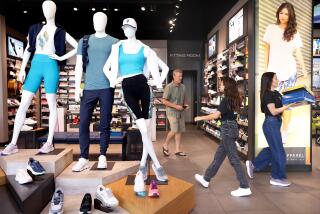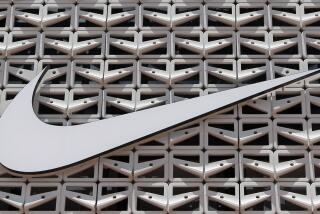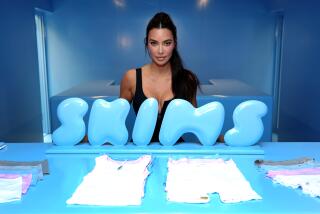Small, Steady Sneaker Company Leaps Ahead of Expectations
- Share via
A photo of Pope John Paul II wearing K-Swiss sneakers is on prominent display at the shoe manufacturer’s corporate headquarters in Westlake Village.
But it’s not just the pope (photographed during a 1996 hiking jaunt in Colorado) who is a fan. Thanks to a successful marketing campaign aimed at young, fashion-conscious consumers, K-Swiss sales and stock prices are soaring toward the heavens, and investors have been turned into true believers.
While competitors such as Nike and Reebok struggled during 1998, tiny K-Swiss Inc., whose sales account for only about 1% of the annual $13-billion global athletic shoe market, emerged boasting record revenues and its highest net earnings in four years.
Total revenues for the year ended Dec. 31 were $161.5 million, a 39% increase over 1997, while earnings nearly tripled to $12.5 million. On the strength of those numbers, which the company unveiled in February the same day it announced an upcoming stock split and dividend increase, K-Swiss’ stock took off; share prices reached $68.25 (compared with a 1998 low of $16) before closing at $54 Friday, the last trading day before the stock split Monday. After the split, shares closed at $27.19.
To some extent, K-Swiss’ recent experience is an example of how slow and steady wins the race. The company’s best-selling product is a white, all-leather model called the Classic, which has remained virtually unchanged since it was developed as a competitive tennis shoe 33 years ago.
Returned to stores at a rate less than 1%, the shoe has enjoyed both renewed popularity among consumers and loyalty from retailers who know its enduring style make it less likely to end up dumped in sale bins at the end of a season, said Chief Executive Steven Nichols.
By focusing on its Classic line, which accounts for about half of all sales, K-Swiss has cast itself as the Volvo of the sneaker set.
“Swiss stands for things like durability and timelessness. We design shoes that are of high quality and are a bit more timeless than some of our competitors,” Nichols said.
K-Swiss shoes are actually made in China and other Asian countries. No matter. To further stimulate demand, the company has injected its entire line with a degree of snob appeal by limiting the number of stores where customers can find its shoes. K-Swiss takes it as a point of pride that its products aren’t sold at Big 5, Mervyn’s and Sears, Nichols said. But it’s not only this proverbial tortoise that accounts for K-Swiss’ strong showing last year. Both Nichols and several analysts attribute the company’s recent growth to more aggressive marketing and the launch of several trendier Classic spinoffs that were big hits with teenagers and young adults. Two limited edition models designed for casual wear, the Altezo and the Sentir, did especially well and accounted for 86% of the 1.4 million additional pairs of K-Swiss shoes that were shipped in 1998.
The new products were introduced on the heels of an intensified television advertising campaign--last year, K-Swiss doubled its television spending to $8 million--targeting cable channels, such as MTV and ESPN, and youth-oriented prime-time fare such as “Dawson’s Creek,” “Moesha” and “Buffy the Vampire Slayer.”
“We have always sold to young people who had a feeling that we were special. We just have more of them now who feel we are special,” Nichols said.
This year, K-Swiss is again upping its television ad budget, to $17 million.
One welcome byproduct of the ad-driven popularity of the K-Swiss line has been an increasing demand for the company’s apparel and accessories. Another is growth in its children’s line. Revenues from kids shoes have doubled during the last two years and now account for 22% of sales.
“A lot of kids want to wear what their parents wear,” said Nichols, who was an executive with children’s shoemaker Stride-Rite Corp. until he led a group of investors that acquired K-Swiss in a 1986 leveraged buyout.
The 1998 picture wasn’t all positive, however. In keeping with its heritage as a maker of shoes for serious tennis players, K-Swiss still markets a line of high-end tennis shoes and counts as part of its loyal customer base about one-quarter of the people who play tennis more than two to three times a week, said Nichols. But sales in that category were flat last year. And international sales were down by one-third, a trend Nichols attributes to economic problems in places like Japan and Hong Kong, where K-Swiss historically has been one of the top-selling brands.
Nichols has nevertheless won praise from market analysts for his strategy of selectively expanding the range of K-Swiss products while playing off the strengths of the original Classic.
Merrill Lynch analyst Brenda Gall said K-Swiss is showing “outstanding sales momentum.” She noted that the company’s fourth-quarter earnings exceeded already optimistic expectations by increasing 186% from the year-earlier period and that its order backlog was up 117% for the first six months of this year.
“Based on its successful program of limiting distribution and keeping new updated Classic models on tight allocation, plus its stepped-up marketing campaign, these trends should continue positive in 1999,” Gall wrote in an updated forecast released in early February after K-Swiss announced its fourth-quarter earnings.
At that time, Merrill Lynch raised its estimate on per-share profits for the year to $3.75-$4 and $4.50-$4.75 for the year 2000, compared with 1998 earnings-per-share of $2.20. Coupled with the stock split and dividend increase, such bullish projections sent K-Swiss’ share prices soaring. They almost doubled, but since then, investor fervor has cooled slightly--during the last two weeks, it has hovered mostly in the mid-$40 range.
“I got a feeling that maybe at $65 people took profits and at $44 maybe the same people started rebuying” the stock, Nichols said Friday. He added that if necessary, the company could spend $17 million this year buying back outstanding shares of its stock to bolster performance as it did last year.
For 1999, the company is increasing, from two to four, its offerings of new limited-edition Classic spinoffs, updating the colors of more existing models and launching a new line of cross-training shoes. It also plans to more heavily promote the original Classic tennis-shoe line. Although results for the first quarter ending March 31 won’t be made public until April 21, Nichols said the company’s sales volume reached record levels in January and that orders for the second quarter are well above where they were during the same period a year earlier.
“One advantage of being small is it’s a lot easier for us to double than Nike or Reebok. It would probably be impossible for Reebok to double now,” said Nichols. “But we would also enjoy being profitable as a slightly larger piece of the pie.”
(BEGIN TEXT OF INFOBOX / INFOGRAPHIC)
Star Shoemaker
Despite a recent decline, shares in Chatsworth shoemaker K-Swiss are still almost three times higher than a year ago.
April 2, 1998
Close: $20.12
*
March 26, 1999
Close: $54
More to Read
Inside the business of entertainment
The Wide Shot brings you news, analysis and insights on everything from streaming wars to production — and what it all means for the future.
You may occasionally receive promotional content from the Los Angeles Times.










